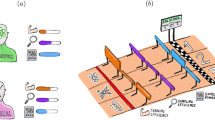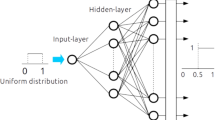Abstract
Quantum generative adversarial networks (QGANs) have a potential exponential advantage over classical GANs, which has attracted widespread attention. However, it also faces the barren plateau problem, i.e., the gradient of variational quantum circuits (VQCs) initialized with random initial parameters decreases exponentially as the number of circuit layers and parameters increases. In order to solve this problem, a hybrid quantum-classical GANs algorithm based on inherited layerwise learning with circle-connectivity circuit (ILL-QGAN) is proposed. The shallow-depth circuit is gradually added during optimization process, and only subsets of parameters are updated, which reduces the number of parameters and circuit depth in each training step. Besides, the parameters trained from the previous layer are inherited to the next layer, which provides the favorable initial parameters for the later. In addition, in order to offer relatively favorable expressibility and entangling capability, the generator uses a more near-term circuit structure, i.e., circle connectivity, to construct VQCs. Finally, the BAS and handwritten experiments are conducted on PennyLane to show our algorithm can faster converge to the Nash equilibrium point and obtain higher accuracy than existing quantum algorithms. Since the shallow-depth and circle-connectivity circuit are used, our algorithm is preferable for execution on noisy intermediate-scale quantum devices.













Similar content being viewed by others
Explore related subjects
Discover the latest articles, news and stories from top researchers in related subjects.Data availability
The datasets generated during and/or analyzed during the current study are available from the corresponding author upon reasonable request.
References
Goodfellow, I.J., Pouget-Abadie, J., Mirza, M., Xu, B., Warde-Farley, D., Ozair, S., Courville, A., Bengio, Y.: Generative adversarial nets. In: Proceedings of the 27th International Conference on Neural Information Processing (ICONIP), pp. 2672–2680. MIT Press, Montreal (2014)
Zhu, J.Y., Krahenbuhl, P., Shechtman, E., Efros, A.A.: Generative visual manipulation on the natural image manifold. In: European Conference on Computer Vision (ECCV), pp. 597–613. Spring, Berlin (2016). https://doi.org/10.1007/978-3-319-46454-1_36
Ledig, C., Theis, L., Huszar, F., Caballero, J., Cunningham, A., Acosta, A., Aitken, A., Tejani, A., Totz, J., Wang, Z.H., Shi, W.Z.: Photo-realistic single image super-resolution using a generative adversarial network. In: 2017 IEEE Conference on Computer Vision and Pattern Recognition (CVPR), pp. 105–114. IEEE, USA (2017). https://doi.org/10.1109/CVPR.2017.19
Wang, C.Y., Xu, C., Wang, C.H., Tao, D.C.: Perceptual adversarial networks for image-to-image transformation. IEEE Trans. Image Process. 27(8), 4066–4079 (2017). https://doi.org/10.1109/TIP.2018.2836316
Gao, X., Zhang, Z.Y., Duan, L.M.: A quantum machine learning algorithm based on generative models. Sci. Adv. 4(12), 1–17 (2018). https://doi.org/10.1109/TIP.2018.2836316
Benedetti, M., Garcia-Pintos, D., Perdomo, O., Leyton-Ortega, V., Nam, Y., Perdomo-Ortiz, A.: A generative modeling approach for benchmarking and training shallow quantum circuits. NPJ. Quantum. Inf. 5(1), 45 (2019). https://doi.org/10.1038/s41534-019-0157-8
Lloyd, S., Weedbrook, C.: Quantum generative adversarial learning. Phys. Rev. Lett. 121(4), 040502 (2018). https://doi.org/10.1103/PhysRevLett.121.040502
Situ, H.Z., He, Z.M., Wang, Y.Y., Li, L.Z., Zheng, S.G.: Quantum generative adversarial network for generating discrete distribution. Inf. Sci. 538, 193–208 (2020). https://doi.org/10.1016/j.ins.2020.05.127
Romero, J., Aspuru-Guzik, A.: Variational quantum generators: generative adversarial quantum machine learning for continuous distributions. Adv. Quantum Technol. 4(1), 2000003 (2021). https://doi.org/10.1002/qute.202000003
Liu, W.J., Zhang, Y., Deng, Z.L., Zhao, J.J.: A hybrid quantum-classical conditional generative adversarial network algorithm for human-centered paradigm in cloud. EURASIP J. Wirel. Comm. 2021(1), 37 (2021). https://doi.org/10.1186/s13638-021-01898-3
Huang, H.L., Du, Y.X., Gong, M., Zhao, Y.W., Wu, Y.L., Wang, C.Y., Li, S.W., Liang, F.T., Lin, J., Xu, Y., Yang, R., Liu, T.L., Hsich, M.H., Deng, H., Rong, H., Peng, C.Z., Lu, C.Y., Chen, Y.A., Tao, D.C., Zhu, X.B., Pan, J.W.: Experimental quantum generative adversarial networks for image generation. Phys. Rev. Appl. 16(2), 024051 (2021). https://doi.org/10.1103/PhysRevApplied.16.024051
McClean, J.R., Boixo, S., Smelyanskiy, V.N., Babbush, R., Neven, H.: Barren plateaus in quantum neural network training landscapes. Nat. Commum. 9, 4812 (2018). https://doi.org/10.1038/s41467-018-07090-4
Grant, E., Wossnig, L., Ostaszewski, M., Benedetti, M.: An initialization strategy for addressing barren plateaus in parametrized quantum circuits. Quantum 3, 214 (2019). https://doi.org/10.22331/q-2019-12-09-214
Volkoff, T., Coles, P.J.: Large gradients via correlation in random parameterized quantum circuits. Quantum Sci. Technol. 6(2), 025008 (2021). https://doi.org/10.1088/2058-9565/abd891
Skolik, A., Mcclean, J.R., Mohseni, M., van der Smagt, P., Leib, M.: Layerwise learning for quantum neural networks. Quantum Mach. Int. 3(1), 5 (2021). https://doi.org/10.1007/s42484-020-00036-4
Kiani, B.T., Palma, G.D., Marvian, M., Liu, Z.W., Lloyd, S.: Quantum earth mover’s distance: a new approach to learning quantum data (2021). arXiv:2101.03037
Niu, M.Y., Zlokapa, A., Broughton, M., Boixo, S., Mohseni, M., Smelyanskyi, V., Neven, H.: Entangling quantum generative adversarial networks. Phys. Rev. Lett. 128(22), 220505 (2022). https://doi.org/10.1103/PhysRevLett.128.220505
Puchała, Z., Miszczak, J.A.: Symbolic integration with respect to the haar measure on the unitary groups in mathematica. Physics 65(1), 21–27 (2011). https://doi.org/10.1515/bpasts-2017-0003
Zhu, D., Linke, N.M., Benedetti, M., Landsman, K.A., Nguyen, N.H., Alderete, C.H., Perdomo-Ortiz, A., Korda, N., Garfoot, A., Brecque, C., Egan, L., Perdomo, O., Monroe, C.: Training of quantum circuits on a hybrid quantum computer. Sci. Adv. 5(10), 9918 (2019). https://doi.org/10.1126/sciadv.aaw9918
Sim, S., Johnson, P.D., Aspuru-Guzik, A.: Expressibility and entangling capability of parameterized quantum circuits for hybrid quantum-classical algorithms. Adv. Quantum Technol. 2(12), 2000063 (2019). https://doi.org/10.1002/qute.201900070
Hubregtsen, T., Pichlmeier, J., Stecher, P.: Evaluation of parameterized quantum circuits: on the relation between classification accuracy, expressibility, and entangling capability. Quantum Mach. Int. 3(1), 9 (2021). https://doi.org/10.1007/s42484-021-00038-w
Goodfellow, I.: NIPS 2016 tutorial: generative adversarial networks (2016). arXiv:1701.00160
Dua, D., Graff, C.: UCI machine learning repository (2017)
PennyLane. https://pennylane.ai/ (2018)
Acknowledgements
This work is supported by the National Natural Science Foundation of China (62071240, 61802175) and the Priority Academic Program Development of Jiangsu Higher Education Institutions (PAPD).
Author information
Authors and Affiliations
Corresponding author
Additional information
Publisher's Note
Springer Nature remains neutral with regard to jurisdictional claims in published maps and institutional affiliations.
Rights and permissions
Springer Nature or its licensor (e.g. a society or other partner) holds exclusive rights to this article under a publishing agreement with the author(s) or other rightsholder(s); author self-archiving of the accepted manuscript version of this article is solely governed by the terms of such publishing agreement and applicable law.
About this article
Cite this article
Liu, W., Zhao, J. & Wu, Q. A hybrid quantum-classical generative adversarial networks algorithm based on inherited layerwise learning with circle-connectivity circuit. Quantum Inf Process 21, 372 (2022). https://doi.org/10.1007/s11128-022-03719-y
Received:
Accepted:
Published:
DOI: https://doi.org/10.1007/s11128-022-03719-y




